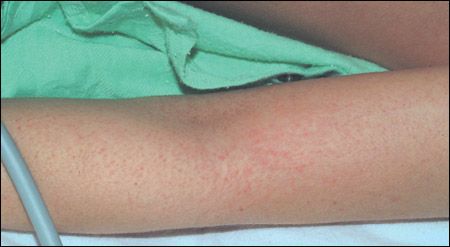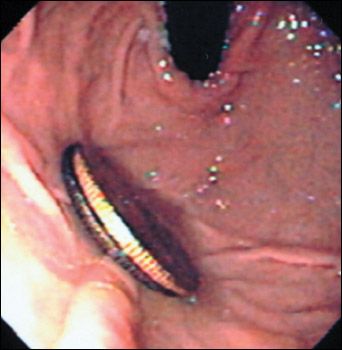Allergic Reaction to Nickel in Swallowed Coins
An 8-year-old boy seen at a gastroenterology clinic after "accidentally" swallowing 2 coins 4 days earlier. Had difficulty in breathing shortly after swallowing the coins and was taken to emergency department. X-ray films at that time demonstrated coins in his esophagus. Patient was immediately transferred to a tertiary care facility. Repeated x-rays showed the coins in his stomach. Patient was sent home with instructions to follow up with his pediatrician in 1 to 2 days.

HISTORY
An 8-year-old boy seen at a gastroenterology clinic after "accidentally" swallowing 2 coins 4 days earlier. Had difficulty in breathing shortly after swallowing the coins and was taken to emergency department. X-ray films at that time demonstrated coins in his esophagus. Patient was immediately transferred to a tertiary care facility. Repeated x-rays showed the coins in his stomach. Patient was sent home with instructions to follow up with his pediatrician in 1 to 2 days.
Two days later, the pediatrician noted a generalized rash and became concerned about Stevens-Johnson syndrome. A course of oral corticosteroids was started. X-ray films showed coins still in the patient's stomach.
The patient was referred for GI evaluation and possible endoscopic removal of the coins.
PHYSICAL EXAMINATION
Alert afebrile patient in no apparent distress. Developmentally age-appropriate. Breath sounds, clear to auscultation; heart, regular rate and rhythm. Abdomen, soft, nondistended, and nontender to palpation. Rash generalized, erythematous, maculopapular, vesicular, and pruritic; more pronounced on patient's back, chest, and lower extremities. No mucosal involvement. No lymphadenopathy.
"WHAT'S YOUR DIAGNOSIS?"
ANSWER: ALLERGIC REACTION TO NICKEL IN THE SWALLOWED COINS

Figure 1 – The swallowed coins as seen on endoscopy (the darker coin is the Canadian quarter).
MEDICAL HISTORY
Patient has experienced rashes in the periumbilical area after wearing jeans. Tolerates a normal diet. No recent history of travel or sick contacts. No history of fever, vomiting, abdominal pain, or diarrhea. No respiratory symptoms other than breathing difficulty immediately after swallowing the coins. No significant family history.
Based on a history of a similar rash in the periumbilical area after exposure to a nickel-containing jeans stud, and the lack of constitutional symptoms, it is most likely that this patient's rash is an allergic reaction to the nickel component of the coins he swallowed. The quarters were removed endoscopically (Figures 1and 2). One of the coins was a Canadian quarter, composed of 100% nickel without plating.1 The other was a US quarter, composed of a copper-nickel alloy.2 During endoscopy, it was noted that gastric mucosa in contact with the quarters had eroded. Therefore, a 1-week course of ranitidine was started.
The patient did well thereafter and the rash resolved within 2 days after the coins were removed.

Figure 2 – The coins after removal show the changes in the Canadian quarter.
DISCUSSION
Most people come in contact with nickel daily. This metal is found in such items as coins, clothing, jewelry, orthodontic appliances--and even in most foods. In general, nickel exposure alone does not trigger an immune response unless the person has already been sensitized to it or unless there are exogenous factors, such as nickel in direct contact with irritated skin or direct exposure to body fluids (eg, sweat or gastric acid).3
An allergic reaction to nickel is a type IV hypersensitivity response, which occurs in 2 phases. During the first phase, sensitization occurs on initial exposure to an antigen, with a resulting immune response. Typically this response develops within 10 to 14 days after exposure; clinical symptoms may not be present. The second phase (elicitation) occurs within 12 to 24 hours of reexposure to the antigen.4 Clinical symptoms are likely to be noted in this phase.5 For example, a person with an allergic reaction to an orthopedic device may present with pain and joint instability as well as local inflammatory symptoms.4 Dental appliances that contain nickel can cause white oral hyperkeratotic lesions similar to leukoplakia.6 Dental appliances can also cause systemic symptoms, such as rash.5
As noted, the child in this case had a history of periumbilical rash after wearing jeans. He probably had already been sensitized to nickel and was in the elicitation phase of a hypersensitivity reaction.
When Is Watchful Waiting Appropriate? Foreign-body ingestion is a common problem among pediatric patients. Children who swallow objects are at risk for such problems as breathing difficulty or allergic reactions. Burn injury has been reported following battery ingestion.
12
Usually no intervention is needed when an ingested rounded foreign body has reached the stomach, unless it is causing symptoms-as it did in our patient. In deciding how to treat in this setting, consider the patient's age; the type of object swallowed; and the presence of symptoms, such as difficulty in breathing or rash. For the asymptomatic child over 2 years old in whom the object has passed into the stomach, watchful waiting is appropriate.
13
Children younger than 2 years or who are experiencing symptoms must be treated more aggressively to prevent further complications.
TREATMENT
Treatment of a type IV hypersensitivity response depends on the severity of symptoms. Patients with mild reactions generally respond to symptomatic treatment with cool compresses or oral antihistamines. Those with moderate to severe reactions can be treated with topical corticosteroids in a strength appropriate for the body site affected7 or with topical macrolide immunomodulators, such as tacrolimus or pimecrolimus.8 Persons with acute, severe reactions should receive oral corticosteroids for 2 weeks. A tapering schedule is not necessary because of the short duration of therapy. Advise patients (or their parents) to complete the full 2-week course because of the risk of relapse associated with shorter therapy.7
Treatment must also include allergy testing and education. Encourage patients with suspected nickel allergy to have a patch test to determine whether allergy is likely.9 It is impossible to avoid nickel completely. Therefore, patients who test positive for this allergy need to know how to minimize contact with this metal. For example, nickel-containing items that may come in contact with skin, such as metal fasteners or jewelry, should be coated with clear nail polish.10 A dimethylglyoxine test can be used to identify whether a particular object contains nickel. A low-nickel diet--devoid of certain canned foods (spaghetti, baked beans, vegetables, fruits), green beans, broccoli, peas, dried fruit, and nuts--has been suggested.11 The effectiveness of this diet is questionable, however, because nickel is present in most foods.
References:
REFERENCES:
1. Royal Canadian Mint. Available at:
www.mint.ca/en/business_services/ plating/innovation.htm
. Accessed March 10, 2005.
2. The United States Mint. US Department of Treasury. Available at: www. usmint.gov/about_the_mint/index.cfm?action=coin_specifications. Accessed March 15, 2005.
3. Artik S, Haarhuis K, Wu X, et al. Tolerance to nickel: oral nickel administration induces a high frequency of anergic T cells with persistent suppressor activity.
J Immunol.
2001;167:6794-6803.
4. Rabin S. Immune response to implants. 2004. Available at: www.emedicine. com/orthoped/topic615.htm. Accessed March 15, 2005.
5. Rahilly G, Price N. Nickel allergy and orthodontics.
J Orthod.
2003;30:171-174.
6. Tosti A, Piraccini BM, Pazzaglia M. Contact stomatitis. 2003. Available at: www.emedicine.com/derm/topic647.htm. Accessed March 15, 2005.
7. Hogan D. Contact dermatitis, allergic. 2004. Available at: www.emedicine.com/ derm/topic84.htm. Accessed March 15, 2005.
8. Nghiem P, Pearson G, Langley RG. Tacrolimus and pimecrolimus: from clever prokaryotes to inhibiting calcineurin and treating atopic dermatitis.
J Am Acad
Dermatol.
2002;46:228-241.
9. Crowe MA. Contact dermatitis. 2004. Available at: www.emedicine.com/ped/ topic2569.htm. Accessed March 15, 2005.
10. Waite M. A fashionable approach to nickel allergy.
Contemp Pediatr.
2004; 21:19.
11. Nickel allergy. 2004. Available at: www.dermnetnz.org/dermatitis/ nickel-allergy.html. Accessed March 15, 2005.
12. Steinberg K. Battery ingestion. 2000. Available at: www.emedicine.com/ aaem/topic37.htm. Accessed March 15, 2005.
13. Gomez R, Basson MD. Rethinking the watchful waiting approach to the swallowed coin problem.
Surgery.
2003;133:698-699.
Recognize & Refer: Hemangiomas in pediatrics
July 17th 2019Contemporary Pediatrics sits down exclusively with Sheila Fallon Friedlander, MD, a professor dermatology and pediatrics, to discuss the one key condition for which she believes community pediatricians should be especially aware-hemangiomas.